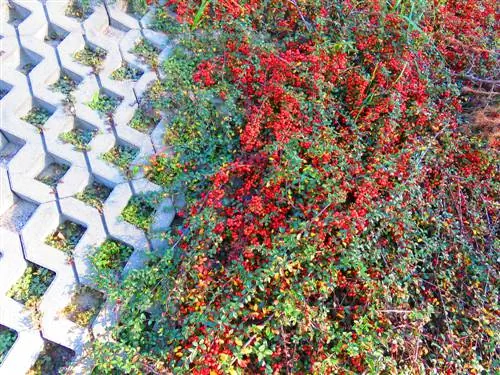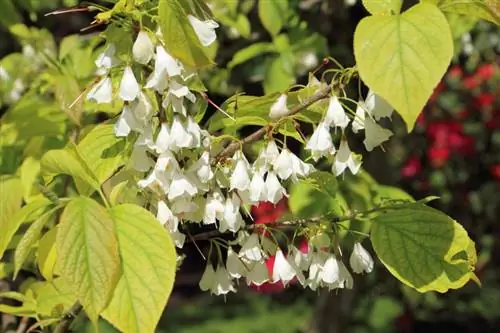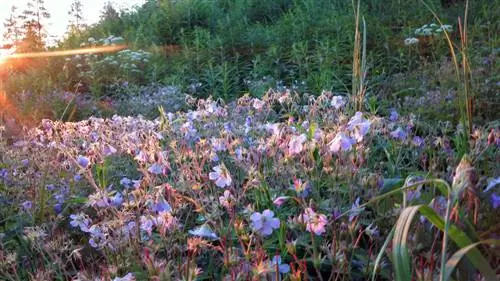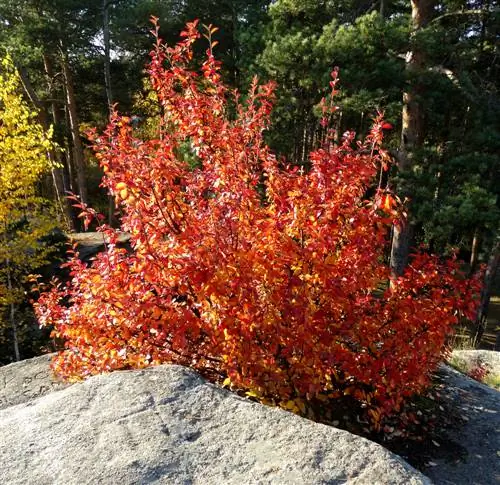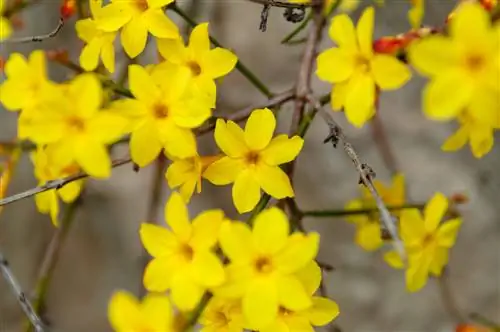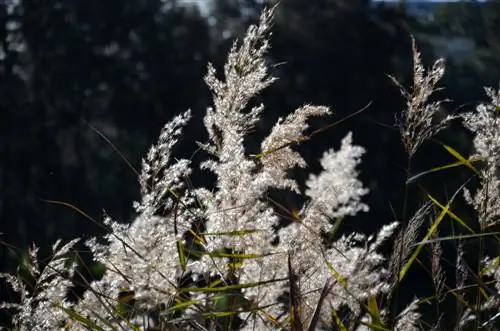- Author admin [email protected].
- Public 2023-12-25 17:45.
- Last modified 2025-01-23 11:21.
Cotoneasters are known from the greening of areas in parks and on street islands. But they can do much more than just cover the ground. If you provide the plant with a suitable location, you can enjoy its easy-care beauty for many years.
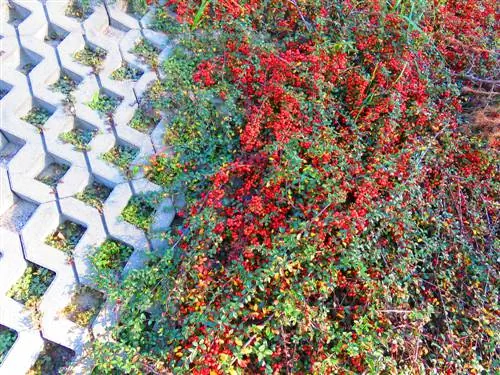
What is a cotoneaster and how do you care for it?
Cotoneasters (Cotoneaster) are versatile rose plants that can be used as ornamental shrubs, ground cover or bonsai. They are easy to care for, prefer sunny to partially shaded locations and well-drained soil. The plants offer attractive flowers, fruits and foliage, but are slightly poisonous.
Origin
The cotoneaster genus includes around 90 species. The rose family is widespread in the temperate climate zones of Asia. Their area extends across Europe to North Africa. The shrubs are primarily distributed in the Himalayan Mountains and southwestern China. Some species have adapted to extreme locations. You climb altitudes of up to 4,000 meters.
Bloom
Few Cotoneaster species develop flowers that are solitary or clustered together in small clusters. The majority have racemose or umbrella-like inflorescences. A flower has a fivefold structure and has both male and female flower organs. The calyx consists of five short leaflets that remain until the fruit ripens. It encloses the crown, which is composed of five leaves.
The flowers can be white, pink, cream, light purple or red in color. The flowering period begins in May or June and lasts until autumn. Cotoneaster species are important food suppliers for native insects. The sweet scent of flowers attracts numerous wild bees and butterflies.
Fruit
After the flowers wither, small drupes emerge. They are reminiscent of miniature apples and are colored red, reddish brown, orange or yellow. In some species the color changes to black. The fruits are an important source of food for birds. They eat the small fruits, especially in winter.
leaves
Cotoneasters have alternately arranged leaves, the leaf blades of which are short-stalked. The sturdy leaves are simple in structure and have a smooth edge. The dense foliage is typical of all Cotoneaster species. The foliage is shiny dark green and remains intact even in winter for many members of the genus. There are tiny stipules at the base of the leaves.
Growth
The species are deciduous or evergreen. There are representatives that grow tree-shaped and reach heights of up to 15 meters. The majority are shrubs or dwarf shrubs that crawl over the ground with their prostrate shoots. In contrast to the related firethorn species, the branches of the cotoneaster do not have thorns.
Usage
Cotoneasters serve as low hedge borders for beds and perennial plantings. They can be planted alone or as a companion to roses. The weakly growing species cut a fine figure in the rock garden. Taller growing varieties are suitable for creating hedges and topiaries. They can be perfectly integrated into shrub borders as a group of shrubs.
Groundcover
Cotoneaster species are very popular in area greening. Their low growth makes them perfect ground cover plants that do not require much care. They are just as common in public green spaces and on traffic islands as they are on embankments. Here, the extensive growth also ensures slope stabilization. The root system holds the substrate together and the plant body protects the soil from heavy rainfall. This means that creeping cotoneasters play an important role in protecting against soil erosion. As ground cover, Cotoneaster species are very popular in grave planting.read more
Bonsai
Cotoneasters are perfect as bonsai because their design options are versatile. You can arrange suitable plant material into a freely upright or inclined shape. Cascades and semi-cascades can be easily designed with targeted cuts. You can plant rocks or let the roots grow over rocks. Double trunks or group plantings are also possible.
Cotoneaster species are not suitable as indoor bonsai. They need fresh air and a sunny to partially shaded location. You can purchase suitable material at hardware stores. Particularly old specimens can often be found at disposal stations in cemeteries.
Why the cotoneaster is suitable as a bonsai
- high sprouting power after radical pruning
- uncomplicated care
- suitable for beginners
- Cascade design very possible
- very small leaves with attractive autumn colors
read more
Is cotoneaster poisonous?
All parts of the plant contain the glycoside amygdalin, which is similar to hydrogen cyanide. It is considered slightly toxic and should not be consumed, although he alth problems only occur after consuming large quantities. Ten to 20 fruits can cause vomiting diarrhea.
House tigers have the habit of nibbling on green plants. The ingredients in cotoneaster develop their toxic effects on cats more quickly than on people. Difficulty breathing, heart palpitations and vomiting may occur. Dogs have a more developed sense of taste than velvet paws. They usually avoid the fruits after an initial test. However, you should keep your dogs away from the plants as they are highly toxic.
Which location is suitable?
Cotoneasters thrive in a sunny or partially shaded location. The more sun the plants get, the greater the flower splendor. Their high adaptability makes them popular ornamental shrubs. They cope well with heat and dry periods.
What soil does the plant need?
The shrubs require nutrient-rich soil that offers permeable properties. The lime-tolerant plants cannot tolerate waterlogging. To loosen the soil, you can mix in some gravel or sand. If these conditions are present, cotoneasters grow in almost all domestic soils. You can use regular garden or potting soil.
Propagate cotoneaster
Cotoneasters reproduce independently via above-ground runners. You can separate these from the mother plant from autumn and place them in a new location. The young plants need about a year to grow.
Propagation via lowering plants is possible. To do this, the tip of a shoot is scored crosswise and fixed to the ground with a stone so that the tip protrudes from the substrate. It can take up to two years for the sinker to develop roots. Only then can you separate the branch from the mother plant.read more
Sowing
Cotoneaster species are cold germinators. Your seeds need a cold stimulus to encourage them to germinate. Therefore, you should start sowing shortly before winter. Allow the seeds to soak in a growing container filled with substrate for a few days. Keep the substrate evenly moist. Place the pot outside in a protected location where it will remain until spring. The seeds germinate from March.
This propagation method is recommended for wild forms. Sowing is not suitable for breeding true-to-variety offspring because the young plants have different combinations of characteristics than their parent plants.
Cuttings
Cut off shoot tips about ten centimeters long from your cotoneaster and remove the lowest leaves. Fill a planter with potting soil and insert the branches into the substrate. To prevent it from drying out, you can put a glass or plastic cover over the container. The cuttings root after a few weeks.
What is the best time to plant?
Planting takes place in winter. Choose a frost-free day between October and May so that you can loosen the soil better. Cotoneasters are available all year round as container plants that can be planted out at any time. Remove weeds from the substrate and improve the structure of heavy soils with sand or gravel.
The correct planting distance
Depending on the desired density, place the plants loosely or close together. So that the plants can develop optimally, the distance should not be less than 50 centimeters.read more
Cotoneaster in a pot
Certain Cotoneaster species are suitable for container planting. There are refined tall stems that decorate pots all year round with their drooping shoots. Creeping species can also be planted in pots. Choose slow-growing plants so that the space required by the roots remains manageable.
Wide pots with a drain hole are suitable as planters. They ensure water drainage and offer the root ball sufficient opportunities to develop. You can use conventional potting soil as a substrate. The pot should be left outdoors all year round. Protect the root ball from freezing in winter and make sure that the plant is not in direct sun during the cold season. There is a risk of drying out here.
Beautify cotoneasters in the pot:
- Sitting areas on terraces
- Balcony niches
- Steps in house entrances
- Foregrounds of walls
Cut cotoneaster correctly
The shrubs tolerate pruning very well and can be cut back regularly. They sprout reliably even after a radical cut into the old wood. This measure is recommended if you want to rejuvenate ground-cover plants. Shrub-shaped cotoneasters are only thinned out. If they grow too wide, you can shorten the young shoots down to the side branches.
Evergreen species are cut in spring before fresh shoots appear. Deciduous specimens should be cut back in late winter. Topiary cuts are possible until June. Be careful not to cut off too many shoots. This allows the plant to bloom in summer. Dead branches can be removed all year round.read more
Watering cotoneaster
On hot and dry days, the plants enjoy additional watering. If this is omitted, it will not immediately harm the cotoneasters. To improve moisture balance in the soil, you can apply a protective layer of mulch. Potted plants should be watered regularly. They also need water in winter when the days are frost-free.
Fertilize cotoneaster properly
During the growth phase, the plants enjoy a regular supply of nutrients with liquid fertilizer (€13.00 on Amazon), which you administer with the irrigation water. As an alternative to concentrate, you can use granules to provide the plants with additional nutrients. Fertilization is not a must for outdoor plants. Potted plants should be cared for so that they do not wither in the limited space.
How do I transplant correctly?
Transplanting outdoor plants does not make sense, as older specimens have developed a strong root system and are damaged when dug up. Since propagation via cuttings works very reliably, transplanting has not proven successful.
Container plants should be repotted every two to three years so that the roots receive fresh substrate and can continue to expand. If you cultivate your cotoneaster as a bonsai, you should regularly give the plant a new pot. Young plants are repotted every year, older specimens after two to three years. This measure shortens the roots.
Wintering
Cotoneaster species are hardy and survive the frosty temperatures without any problems. Mulching has proven to be effective so that the evergreen plants do not suffer from drought stress. The layer protects the soil from freezing and at the same time provides the roots with moisture. If the plants grow in direct sunlight, you should protect the leaves from the winter sun with plant fleece.
Diseases
Cotoneasters are important host plants for the bacterium Erwinia amylovora, which causes fire blight. It spreads from spring to summer and penetrates the organism through flowers and young shoots. As a result, the parts of the plant wither quickly and die. They curve in and take on a black color. Because leaves and shoots appear burned, the disease has been given the name fire blight.
The bacterium multiplies like an epidemic on surrounding stone fruit. Since there are no effective control methods, you must completely remove infected plants and dispose of them properly or burn them. The disease is reportable. As a preventive measure, you should choose robust varieties and ensure there is sufficient distance from fruit trees when planting so that the bacteria cannot spread unhindered.
Lice
They are among the most common pests that occur on Cotoneaster species. Lice suck the plant sap on the leaf veins, weakening the plant.
Aphids and mealybugs
Cotoneasters are often attacked by aphids and mealybugs. The pests are the main vectors of the fire blight bacteria and should therefore be combated as quickly as possible. Spraying pome fruit plants has proven to be a preventive measure against pests.
When the buds open and the first leaf tips appear, the plants are treated with a special spray. Promanal is often used here. The product is not toxic to beneficial insects and contains rapeseed oil, which settles in the gaps in the bark. It covers eggs and overwintering pests with an oil film so that the pests soon die.
Blood lice
These pests were introduced from America and occasionally attack cotoneasters weakened by a lack of nutrients or an excess of nitrogen. Blood lice have natural enemies. Encourage ladybugs and lacewings. The insects are also eaten by soft beetles, birds or spiders. If your plant is affected, you should regularly remove the lice with a sharp jet of water. Vegetable oil emulsions and ammonia or baking soda solutions help against severe infestations.
Tip
Cotoneasters planted individually appear lost in open spaces. Plant eight specimens together in small groups. The bushes quickly develop a magnificent island of green, which you can loosen up with other bushes such as snow heather, moss roses, broom or stunted pines.
Varieties
- Cotoneaster horizontalis: ground cover. Leaves shiny dark green, rounded. Bright red fruits form a strong contrast to the foliage.
- Cotoneaster salicifolius: Foliage dark green on top, tomentose underneath. Blooms from June, flowers in umbel-shaped panicles, white and strongly fragrant. Grows up to five meters high.
- Eichholz: Ground-covering Cotoneaster dammeri with overhanging branches. Leaves blue-green, red when budding. Creeping growth up to 50 centimeters high.
- Golden Spring: Carpet-forming Cotoneaster dammeri. Foliage dark green, shiny, young leaves yellow-green with speckles. Grows up to 20 centimeters high.

